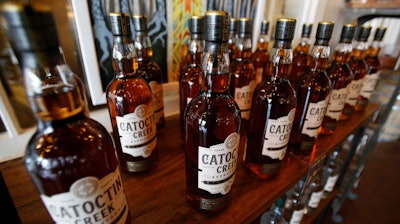
FRANKFORT, Ky. (AP) — President Donald Trump’s trade war dampened the overseas market for American-made whiskey last year, diminishing exports even as the domestic market continues to thrive.
Overall exports of bourbon, Tennessee whiskey and rye whiskey tumbled amid a trade war-induced decline in exports to key European markets. At home, U.S. sales posted solid gains, especially for pricier premium brands, the Distilled Spirits Council reported Wednesday.
For distillers, it was the proverbial glass-half-full, glass-half-empty, scenario. “While it was another strong year for U.S. spirits sales, the tariffs imposed by the European Union are causing a significant slump in American whiskey exports," said Chris Swonger, the council's president and CEO.
American whiskey makers have been caught in the middle of a trans-Atlantic trade dispute since mid-2018, when the EU imposed tariffs on American whiskey and other U.S. products in response to Trump's decision to slap tariffs on European steel and aluminum.
Those duties amount to a tax, which whiskey producers can either absorb in reduced profits or pass along to customers through higher prices — and risk losing market share in highly competitive markets. The tariff headaches continued in 2019, when whiskey makers in the U.S saw their exports decline by 16% to $996 million compared to the prior year, the council said in its report.
American whiskey exports to the EU were down 27% in the last year, it said. American whiskey accounts for 65% of all U.S. spirits exports, and the EU is the top export market for whiskey makers. Exports plunged by nearly 44 percent in Spain, nearly 33 percent in the United Kingdom and almost 20 percent in France, the council said.
At Catoctin Creek Distillery in Virginia, prospects remain bleak for now to rebuild the business it had cultivated in Europe before the tariff fight. “Tariffs remain in place and our business has been at a standstill with virtually no revenue coming in from Europe," said Scott Harris, co-founder and general manager of Catoctin Creek. “We do have whiskey and warehouses in Amsterdam, but with the increased pricing due to tariffs, it doesn't move very fast."
Whiskey producers got a shot of relief last year with an agreement to end retaliatory tariffs that Canada and Mexico had slapped on whiskey and other U.S. products. The new North American trade agreement preserves tariff-free trade for spirits with America's two neighbors, the council said.
Catoctin Creek has managed to gain a foothold in Mexico, where it sold a “small amount" of spirits last year as it tries to find new markets to make up for losses in Europe, Harris said.
Meanwhile, the whiskey industry is hoping for a trade breakthrough with the EU. “We are hopeful that the recent trade agreements will create new momentum for negotiations with the EU," said Christine LoCascio, the council's public policy chief.
While the spirits industry faced stiff headwinds in Europe, it built up more momentum in the U.S. Overall domestic supplier sales rose 5.3 percent to a record $29 billion in 2019, the council said. Total volumes were up 3.3 percent to a record 239 million cases, it said.
Spirits continued to gain market share versus beer and wine in 2019, the council said.
Combined U.S. revenues for bourbon, Tennessee whiskey and rye whiskey rose 10.8%, or $387 million, to $4 billion in 2019, the council said. Domestic volumes were up 8.4% to 26.6 million cases. Rye whiskey continued its upward trajectory with sales growth of 14.7% to reach $235 million.
The strongest revenue growth in the U.S. spirits market continued to come from high-end premium and super-premium products that fetch the highest prices. In the bourbon, Tennessee whiskey and rye segment, super-premium volumes surged by 22% while high-end premium volumes rose 8.2%.
Irish whiskey had another strong year with U.S. revenues up 5.6% to $1.1 billion, the council said. Vodka remains the spirits sector's largest category, representing 31% of all U.S. volume, it said. In 2019, vodka revenues were up 2.9% to $6.6 billion, also driven by strong growth in high-end premium products, it said.






















